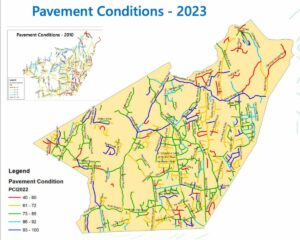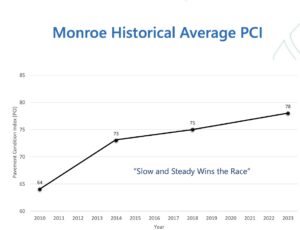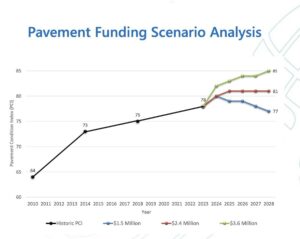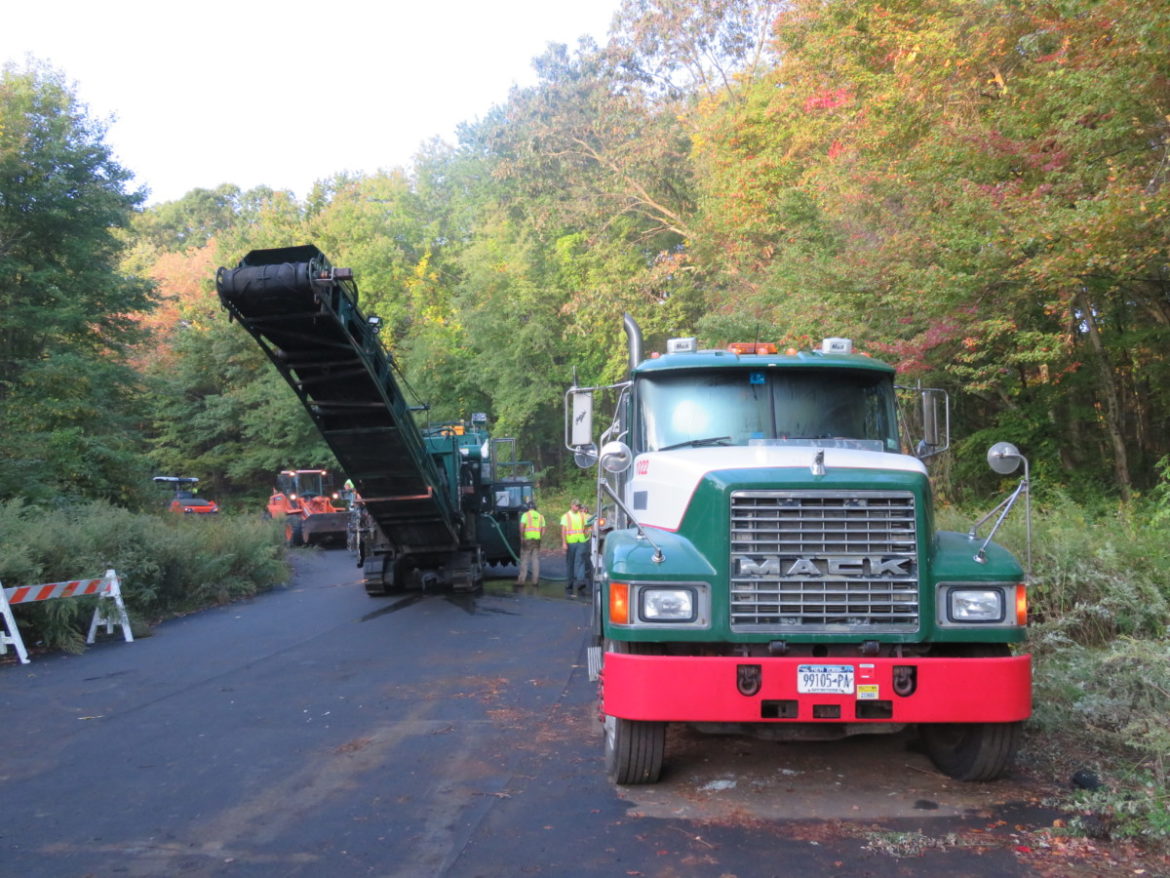MONROE, CT —- Gordon Daring, PE, managing director of VHB, a firm consulting the town on its road maintenance planning, showed Town Council members a 2010 map during a presentation at their meeting Monday night. Road conditions were color coded with red and gold being the worst. Those colors dominated the map, showing Monroe drivers were in for a bumpy ride.
Fast forward to the present, and 2023’s map still shows some gold and red roads, but green, which is 73-85 on a scale of zero to 100 on the Pavement Condition Index (PCI) is much more prominent, along with light blue (86-92) and dark blue (93-100). Over the period, Monroe’s overall PCI improved from 64 to 78.
“I don’t know if a 14 point increase seems like a lot to you or not, but in my experience it takes a longterm commitment by a community to make that kind of increase over time,” Daring said. “It’s not something you can do overnight. It takes a lot and Monroe should be proud of the fact that we have achieved that.”
 VHB did a study of 36 communities of a similar size throughout the Northeast in 2015 and the overall average PCI was 77, so 78 pushes Monroe to just above average.
VHB did a study of 36 communities of a similar size throughout the Northeast in 2015 and the overall average PCI was 77, so 78 pushes Monroe to just above average.
Daring has been helping the town with its five year budget plans and is working closely with Public Works Director Chris Nowacki and Deputy Director Bill Phillips on a three-year pavement maintenance and rehabilitation plan.
During his presentation, Daring shared projections on how much Monroe can improve its 136 miles of roads over five years with three different scenarios: annual investments of $1.5 million, $2.4 million and $3.6 million.
Spending $3.6 million a year would increase Monroe’s PCI to around 85 by 2028, $2.4 million to 81 and $1.5 million could lead to a possible dip to 77, according to the projections.
At least since First Selectman Ken Kellogg was first elected in 2017, Monroe has spent about $2 million on road maintenance annually through a combination of money from the Public Works operating budget, a state Town Aid Road grant and bonding.
Kellogg said the town also applies for other grants that become available. The town budget proposal for fiscal year 2023-24 that voters will decide on Tuesday, May 2, includes a $500,000 Small Town Economic Assistance Program grant, raising funding for road maintenance to $2.5 million.
 One slide in Daring’s presentation included the saying, “slow and steady wins the race,” which is something Kellogg adheres to.
One slide in Daring’s presentation included the saying, “slow and steady wins the race,” which is something Kellogg adheres to.
“We certainly want to continue to improve our PCI,” Kellogg said in a telephone interview Thursday. “I would like to see it get at least to the low to mid-80s, because the consultant said very few communities were so high that every road is like brand new. I want to increase it, but we also need to do it in a way that’s fiscally responsible. There are a lot of capital needs in town, so we want to be sensitive to the tax burden.”
During Monday’s Town Council meeting, Councilman Jason Maur asked Daring if the town would be better off front-loading spending on road maintenance to get more work done, before gradually tapering down, rather than spending a flat amount every year.
“I guess my answer would be, provided that your public works can handle the work and the traffic in town, then probably getting ahead of the game is better than letting the game get ahead of you,” Daring said.
Maur had also asked if drainage work was included in the funding for VHB’s five-year-budget projections. Daring said smaller drainage work would be covered, but not extensive work.
Daring praised Monroe for continuing to make drainage improvements, oftentimes with town crews, protecting roads from water damage.
Bang for its buck
 Consultants from VHB drive a town’s roads to assess conditions, looking at nine different pavement distresses, including cracking, potholes and other distortions in the road’s surface. The width of cracks and percentage of a road in distress is measured and the information is used to calculate a town’s PCI.
Consultants from VHB drive a town’s roads to assess conditions, looking at nine different pavement distresses, including cracking, potholes and other distortions in the road’s surface. The width of cracks and percentage of a road in distress is measured and the information is used to calculate a town’s PCI.
A brand new road is 100 PCI and a zero is for a road that is impassable, according to Daring.
“Once we have that information, we work with your public works staff to develop a series of strategies and associated costs,” he said.
Some roads need nothing and others can be improved with less expensive treatments such as crack sealing and micro-surfacing, which is a thin overlay. Cold in place is a process that recycles and reapplies the existing asphalt.
The most expensive treatment is a full rehabilitation of a damaged road, milling it down to the dirt, repairing the structure and repaving it. The lower cost treatments prolong the life of roads, while reducing the number of full rehabilitations that have to be done at once.
“The lesser traveled roads have the ability for a varying variety of treatment bands,” Nowacki said.
Daring estimated it would cost up to $22 million to rehab Monroe’s entire road system, so like other municipalities, he said the town must stretch its annual maintenance budget as far as it can.
 At the end of First Selectman Steve Vavrek’s last term, as Kellogg was coming in, Nowacki said the town acquired an inspection camera enabling it to do more work on its own. The town later bought its own mill head for smaller jobs and Public Works does a lot of the drainage projects itself.
At the end of First Selectman Steve Vavrek’s last term, as Kellogg was coming in, Nowacki said the town acquired an inspection camera enabling it to do more work on its own. The town later bought its own mill head for smaller jobs and Public Works does a lot of the drainage projects itself.
“We’re trying to get that drainage done at a much lower cost than when you’re using outside vendors,” Kellogg said. “Every dollar you don’t spend there can be used on other capital projects.”
Kellogg said Nowacki and his staff do their best to work with utility companies, keeping track of any underground projects, such as gas or water line replacements, so the town can coordinate roadwork projects, rather than doing a new paving only to have a utility company rip up a section of road and patch it soon after.
The town is also more stringent in its requirements after these jobs are done.
Aquarion Water Company replaced a water main on Pastors Walk last year and Nowacki said the town required the contractor to do a full-width restoration, rather than a utility patch after the work was done.
“The road was too new and we can’t have the checkerboard patch all over the place,” he said.
On the right track
Nowacki said the planning phase for deciding what road projects to do each season is a “laborious process”.
The volume of traffic on a road and the overall needs of the community is taken into consideration during the planning process but, though some less traveled roads can sometimes have a longer wait, Kellogg said the town will get to them all.
Aside from budgeting, Nowacki said weather conditions and manpower can play a role in a paving season.
During Monday’s Town Council meeting, Councilman Terry Rooney expressed a desire to be more proactive, by constantly staying on top of the latest ways to prevent road damage, such as scrutinizing the type of material snow plows spread on the roads to provide traction during winter storms.
“Monroe is definitely headed in the right direction,” Daring said. “It’s just been a gradual improvement over time. It takes dollars and effective management to apply those dollars in an effective manner.”
All respectful comments with the commenter’s first and last name are welcome.






